Wolfsburg Questions Its Own Wisdom With EV Golf
Yes, we know. "2014" sounds so impressively future-y, doesn't it? When we're testing a car and the R&D people involved look at us and say it won't be on the market until 2014, our eyes dilate, too. "Wow," we say to ourselves while keeping a straight face in front of the mega-powerful board member, "That's like space travel and everything!"
So yeah, we get emotional.
It's understandable, too, because we're in the mothership for what seems like half of the world's significant automotive brands. It's the Volkswagen Group's Wolfsburg HQ on the vast verdant lowlands of northern Germany in the region of Lower Saxony. There is no Upper Saxony, by the way. We looked.
We're here to get a personalized infotainment-filled test of the already much commented-on Volkswagen Golf Blue-e-motion. It's coming to the United States in... 2014.
Continue reading Second Drive: 2014 Volkswagen Golf Blue-e-motion...
2014 Volkswagen Golf Blue-e-motion – Click above for high-res image gallery
Yes, we know. "2014" sounds so impressively future-y, doesn't it? When we're testing a car and the R&D people involved look at us and say it won't be on the market until 2014, our eyes dilate, too. "Wow," we say to ourselves while keeping a straight face in front of the mega-powerful board member, "That's like space travel and everything!"
So yeah, we get emotional.
It's understandable, too, because we're in the mothership for what seems like half of the world's significant automotive brands. It's the Volkswagen Group's Wolfsburg HQ on the vast verdant lowlands of northern Germany in the region of Lower Saxony. There is no Upper Saxony, by the way. We looked.
We're here to get a personalized infotainment-filled test of the already much commented-on Volkswagen Golf Blue-e-motion. It's coming to the United States in... 2014.
Continue reading Second Drive: 2014 Volkswagen Golf Blue-e-motion...
Photos copyright ©2011 Matt Davis / AOL, Courtesy of Volkswagen
We did have an opportunity to drive the eGolf (they refer to it this way in company graphics displays, so...) toward the end of 2010 in Los Angeles, yes, but the conditions for getting thorough details were simply not there and the drive was a token 15 minutes in downtown L.A., which revealed little.
So, today we hit the road on the more cruising-style roads of the Wolfsburg area and get serious details. We're with Sören Hinze, one of the key engineers in VW's electric traction technical development group, and the overall head of technology product communication, Harthmuth Hoffmann, who has accompanied the Golf Blue-e-motion everywhere it has gone over the past few months.
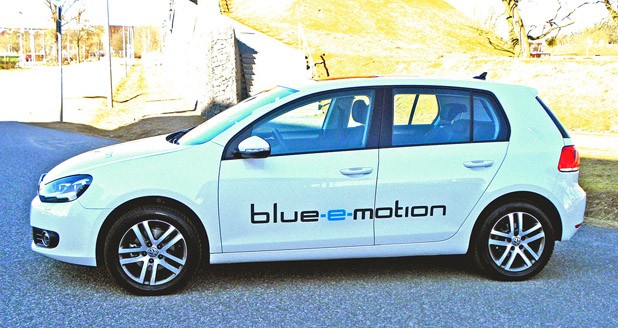
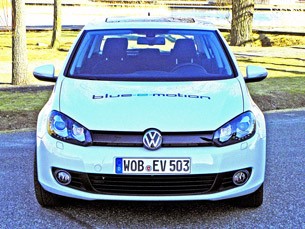
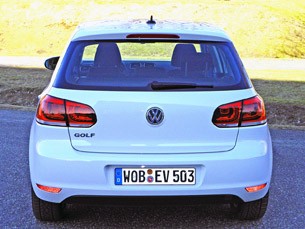
Aesthetically, there's not much to highlight with the exterior. It's a Golf. With stickers. What really is different from a strictly stock exterior is the full feature set of VW's BlueMotion aerodynamic touches. All body panels reduce gaps even further, the grilles and underbody provide less wind resistance, headlights and indicators are combined in one unit, the rear roof spoiler helps make the Golf slipperier and all-season tires are low-rolling resistance units. The central grille in this case is even simpler, too, since theoretically no air-flow is needed on this liquid-cooled electrical drivetrain. Our tires today, however, are rain forest-destroying winter treads – 205/55 16-inch Dunlop SP Winter Sport 3D. It's now German law that winter tires specifically marked "M + S" (mud and snow) must be mounted whenever cold-weather conditions dictate, or it's one point off your license and a $55 fine – $110 if your negligence results in your car blocking traffic.
The roads were dry today, the winter sky gloriously sunny and we were filled with that let's-keep-the-air-clean spirit. The Golf VI currently on the market is by far the quietest hatchback in history, with a level of noise-vibration-and-harshness work seen on cars like the Phaeton or Touareg. Take the internal combustion engine, fuel system and exhaust system away and it's a magic carpet. In fact, the only sound we heard in the cabin besides the typical slight whine of the front AC/DC inverter and electronics management unit (yes, it's an EMU) orchestrating everything up front was that of the dang-blasted winter tires. The coefficient of drag is pretty fine for this boxy configuration at 0.295. Just to be precise.
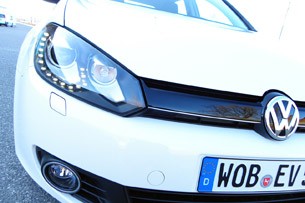
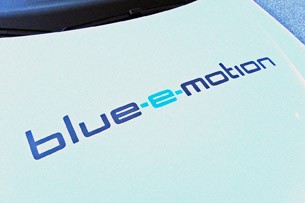
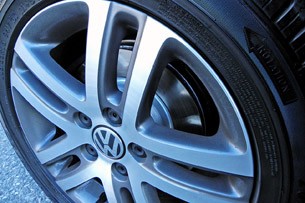
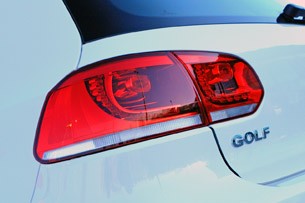
Inside, well, it's also a Golf. The steering wheel with paddles are from the series car with DSG, as is the basic lever by our right thigh on the center console. The paddles in this case work a four-setting brake energy recuperation system, while the console shift lever adds a "B" at the bottom, which takes us straight to the highest level of brake energy recuperation. This extra setting is useful if, for instance, we find ourselves on a very non-Lower Saxon downhill from the Eisenhower tunnel east toward Denver, or whatever hurtling descent you care to mention. The B can also be engaged as heavy resistance as you approach a stop.
Of course, the onboard computer display also takes into account the fact that we're in a lithium-ion-powered electric vehicle. Between the center screen, the analogue dials and our iPhone's VW Remote application, Volkswagen has done everything possible to make certain normal drivers don't experience range anxiety, or to keep them from ever getting caught powerless in the darkest reaches of Lower Saxony or Los Angeles. There are visual reminders everywhere we look of our hypothetical range remaining and the battery pack's current state of charge.
There's no sign of a sunroof on the inside, even though there seems to be one as you look at the Golf Blue-e-motion from the outside. Surprise! It's a solar panel for collecting a little free energy for the battery. Another subtle alteration is the rear cargo floor raised by eight-tenths of an inch for the rear battery element, which lessens slightly the seats-up total capacity reading to 9.7 cubic feet.
In the nearby town of Kassel, Volkswagen's Electro-Mobility Workshop has founded its own manufacturing facility for the 12,000-rpm, 114-horsepower electric motor weighing 176 pounds and mounted in front of the front axle, and driving same. The current 695-pound multi-module array of 180 lithium-ion cells is distributed in such a way that fore-aft weight here reads 50:50 percent, whereas a standard Golf is more front-biased at 55:45. The added 452 pounds of curb weight versus the heaviest series trim car is also placed way down in the structure. This inherently brings on altered dynamics for the drive, which are frankly in some ways better than anything the standard Golf can approach – at least in normal day-to-day toodling around.
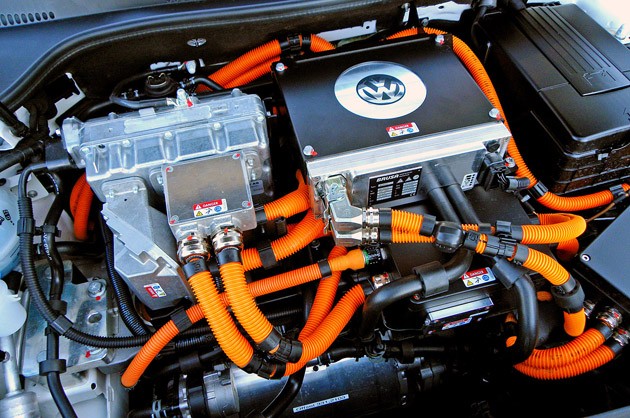
For the moment, VW bosses are not revealing the supplier of the lithium-ion cells since VW (and everyone else in this game) is taking proposals from every reliable source in South Korea, Japan and China. Chief engineer and VW brand board member Ulrich Hackenberg told us over lunch that it's not only a matter of finding the highest-capacity cells at the lowest cost but also of mass production capabilities, the latter, he says, not being truly feasible until 2013. What a timely coincidence....
The current single-speed transmission employed in various forms on VW Group electric and hybrid projects is called EQ 210, and in this case, it uses a sky-high short ratio of 9.8:1 in order to get most all of the electric motor's promised 184 pound-feet of torque to the ground instantaneously from zero rpm. That the Golf Blue-e-motion at 3,410 pounds and with such normal power and torque numbers can haul itself to 60 mph in "just" 11.6 seconds is a testament to this proprietary transmission mounted directly to the stage-left side of the electric motor. Talk about grace under pressure.
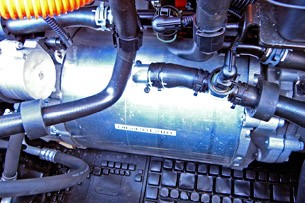
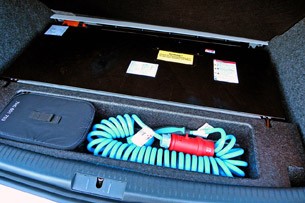
The key to experiencing all of the tree-hugging capabilities of the eGolf, however, is not to keep showing your three pals in the car with you how this thing lays rubber to 60 miles per hour from a stop. There are three drive "profiles" for forward progress – Normal, Comfort+, and Range+, selected via a button in front of the faux-leather skirted shift lever. In Normal and Comfort+ modes, you will not experience the stated possible 93.2-mile range from the 26.5-kWh battery assembly. This distance – as well as the stated distances coming from pies in the sky at any other manufacturer – is sheer delirium. You'll be really lucky on a normal urban day (i.e. ideal conditions) to see 50 miles before crumbling under the stress of range anxiety. All battery-based drive systems allow the batteries to get only as low as 20 percent remaining charge before shutting down operations, too, so "empty" really isn't empty, but more for safety so that all electrical engineers the world over can sleep better at night.
It's so charming that VW has left the ESP Off button on this Golf. We know that it's for when it might be bogged in mud or other low-traction impasses, but if you're trying to get the Golf blue-e-motion into controlled slides, just forget it. Between the 50:50 neutrality of the weight distribution, the plumpness of that curb weight, and the generally un-sporty behavior of the car in anything resembling a slalom, all dreams of smoking tires and mayhem must be set aside for the good of the planet. Such is the story for all electric vehicles around and below this segment of the market – at least for now.
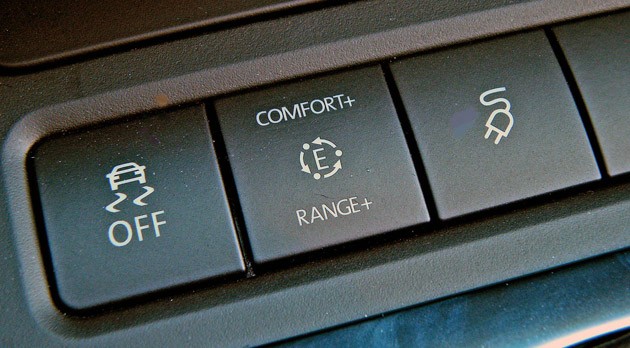
As a drive experience, nothing about the Golf Blue-e-motion surprises a lot. This is their proposal of this type of plug-in, it's quite a capable piece of work and VW is waiting until higher-capacity lithium-ion cells come into real mass production in 2013 – conceivably just to make the price competitive with the Chevrolet Volt/Opel-Vauxhall Ampera. The hatch's current v-max is not terribly interstate-friendly at 84 mph and your overall range would become anxious very quickly then anyways. The proposed VW Blue-e-motion models are, like the Nissan Leaf, confined strictly to the city or suburbs thereof.
The concept of variable kinetic brake energy recuperation is a good one, and on the Golf it goes in stages from minimum to maximum – D, D1, D2, D3 with the left DSG paddle, reverse order using the right paddle. We feel the greater resistance (i.e. recuperation) mostly in D1 and into D2, while D is barely felt and D3 doesn't feel that much greater than D2. The B of the console shift lever is a quick way to reach maximum recuperation while approaching all those stops, or while snaking down the famous one-block stretch of San Francisco's Lombard Street.
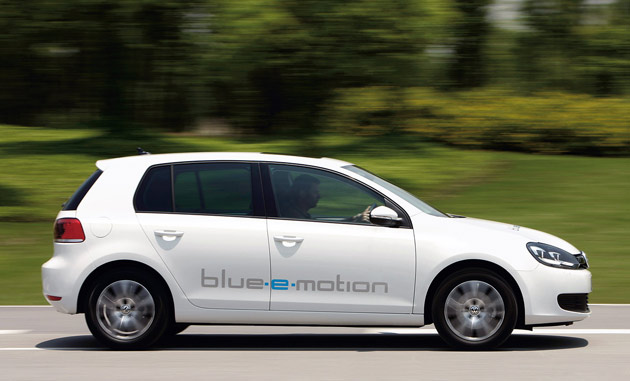
With the Nissan Leaf or Golf Blue-e-motion, the full EV is a necessary changer of one's driving habits. Unless you are an intensely fastidious and sensible person and never drive too far, a sophisticated EV like the eGolf cannot be your only car. Chances are it will be the second or third car in most driveways.
The recharger cable for these eGolf prototypes are European 380-volt monsters that can do a full recharge in about 2.5 hours, but only under closely watched conditions due to any potential Godzilla-wrecks-the-power-station risks. A complete recharge from empty to maximize the next drive's range will take a frustrating 15-ish hours with a 110-volt U.S. plug, dropping to six hours or so if you rewire your garage to 220 volts. Volkswagen's e-mobility group is lobbying with others around the world to get a safe infrastructure standard for 300-to-400-volt quick-charge stations where we can all "fill up" in around 30 minutes. You can notice that, among the many bits VW is still experimenting with, VW is toying with the good idea of letting plug-in operations occur via the front-center VW badge or via the typical fuel cap position. It's one more benefit of an electric car's possibilities.
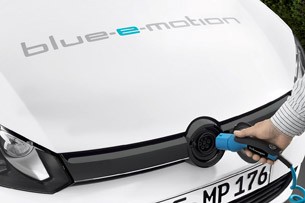
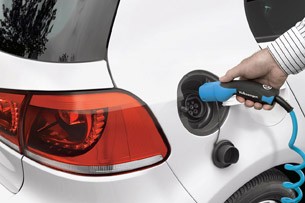
Without getting into too much detail, the VW Remote iPhone application is pretty ingenious stuff allowing you to monitor your Blue-e-motion's recharge progress, current charge levels, interior temperature and possible range depending on your intended journey (which you can send to your car's sat-nav prior to setting out). The possibilities of smartphone-to-car interactivity are numerous. We're just at the beginning of this innovation phase, but already the apps are convincingly intuitive and actually helpful to maximizing one's busy life.
So far as how forward progress feels when choosing Normal, Comfort+, or Range+, in the default Normal mode the EMU lets the system use up to 87 hp and all feels pretty normal around town. In Comfort+ – a questionable name since it's more about power and not comfort – we got the full overboost of 114 hp when needed, even attempting a couple overtake maneuvers that proved slightly comical, though doable. Drop into Range+, and total power on tap is set at 67 hp, which is the steady-state power while cruising anywhere, or "sailing" as they all enjoy telling us. We are reminded of this latter mode from every start, if only because we were wondering if the VW would ever start moving forward. Pedal to the metal time, kids – an action that only helped things a little.
The modified plan is to have 250 Golf Blue-e-motion units in a test fleet distributed between Wolfsburg and Berlin by May of this year. For the United States, a small fleet will begin testing on both coasts in early 2012 – 10 cars kept at VW's Westlake, California, facility and 10 kept in New York City.
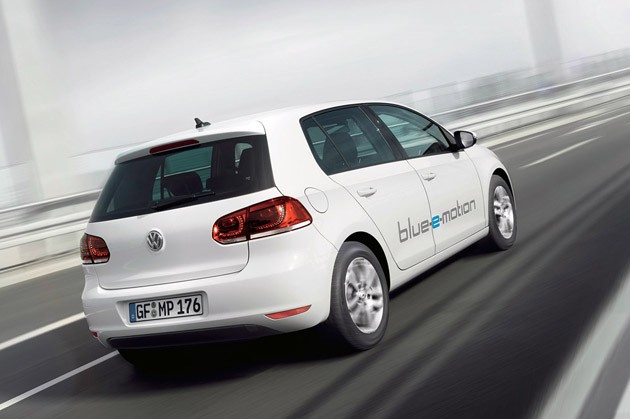
According to Herr Hackenberg, the production Golf Blue-e-motion will hit the market in Western Europe in 2013 and in the U.S. and China in 2014, but it won't actually be a for-sale car, remaining instead a lease-only proposal. This is disappointing, but then it was explained why. VW just doesn't wholly believe in the commercial viability of selling pure EVs on any significant scale. What they envision as a greater strategy is the Toyota Prius-like parallel plug-in hybrid with an ever greater battery energy-holding capacity for greater and greater range and efficiency, plus a dedicated internal combustion engine for the application versus the boat anchor-like normal engines currently used by many. They don't believe in the case for series-type EVs with extended range internal combustion motors since they have not proven terribly efficient setups in the end, as many initial readings on the Chevrolet Volt have made clear.
We're in a period, then, where we cannot wait to see what undoubtedly state-of-the-art configuration VW comes out with for the Golf Blue-e-motion and other models, as the multinational perches above the current EV and extended-range frenzy, waiting for the right moment to do it with intelligence. VW may not be the first into the game, but they want to arrive ready to play hardball. Are they learning from the Koreans? They'd never admit to it.
The future awaits.
Photos copyright ©2011 Matt Davis / AOL, Courtesy of Volkswagen
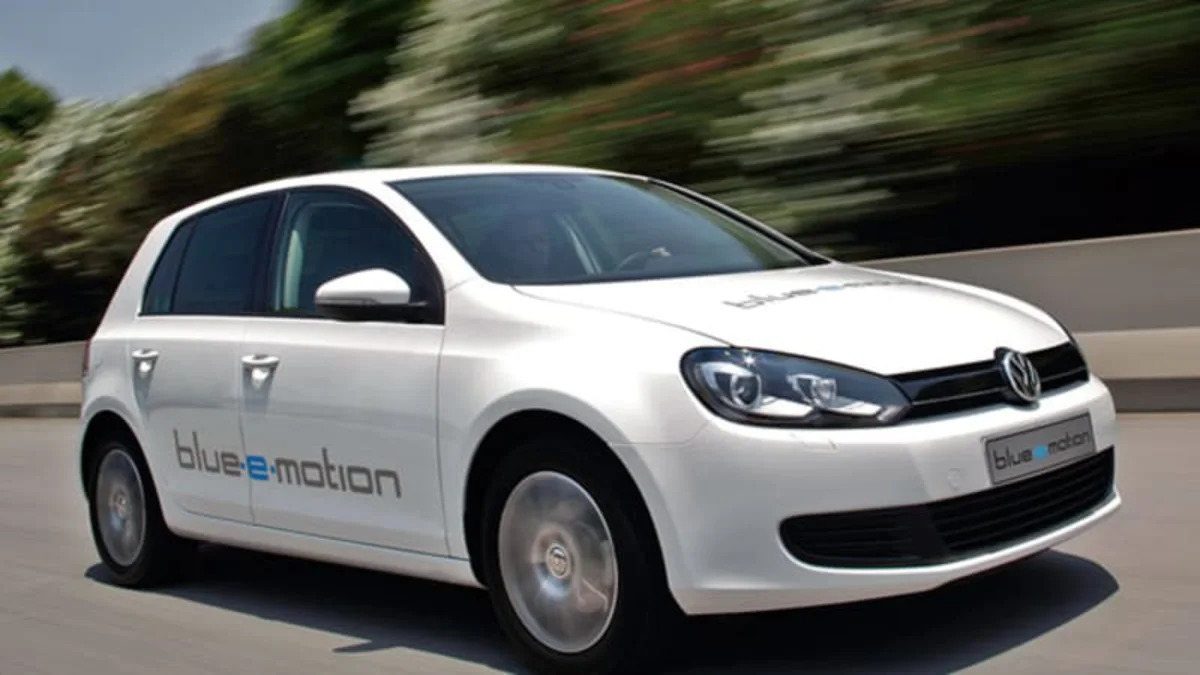

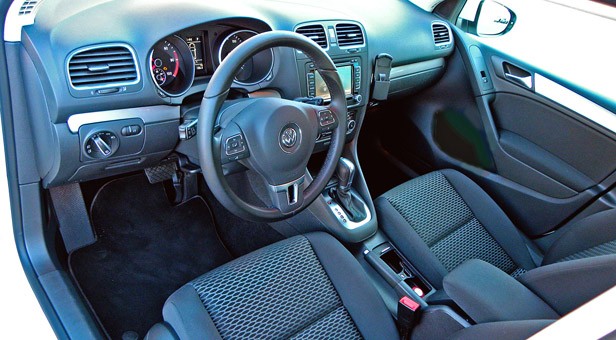
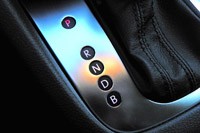
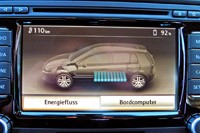
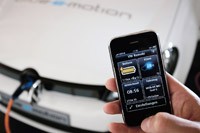

Sign in to post
Please sign in to leave a comment.
Continue